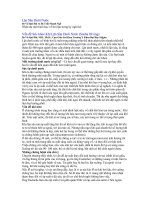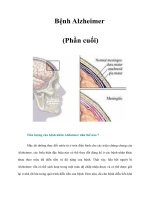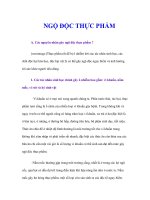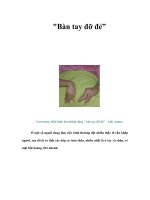Tài liệu Forensic Sciences second edition pptx
Bạn đang xem bản rút gọn của tài liệu. Xem và tải ngay bản đầy đủ của tài liệu tại đây (7.68 MB, 385 trang )
Introduction
to Forensic
Sciences
2nd Edition
WILLIAM G. ECKERT
CRC Press
Boca Raton New York London Tokyo
8101_fm_frame Page i Wednesday, August 7, 2002 10:16 AM
Publisher: Robert B. Stern
Editorial Assitant: Jean Jarboe
Project Editor: Helen Linna
Marketing Manager: Greg Daurelle
Direct Marketing Manager: Bill Boone
Cover design: Dawn Boyd
PrePress: Kevin Luong
Manufacturing: Sheri Schwartz
Library of Congress Cataloging-in-Publication Data
Eckert, William G.
Introduction to forensic sciences, second editon/ William G. Eckert
Originally published: New York: Elsevier, 1992
Includes bibliographical references and index.
ISBN 0-8493-8101-0
1. Forensic sciences. I. Eckert, William G II. Title.
QR749.H64G78 1996
616
′
.0149—dc20
for Library of Congress 96-54316
CIP
This book contains information obtained from authentic and highly regarded sources. Reprinted
material is quoted with permission, and sources are indicated. A wide variety of references are listed.
Reasonable efforts have been made to publish reliable data and information, but the author and the
publisher cannot assume responsibility for the validity of all materials or for the consequences of their use.
Neither this book nor any part may be reproduced or transmitted in any form or by any means,
electronic or mechanical, including photocopying, microfilming, and recording, or by any information
storage or retrieval system, without prior permission in writing from the publisher.
All rights reserved. Authorization to photocopy items for internal or personal use, or the personal or
internal use of specific clients, may be granted by CRC Press, Inc., provided that $.50 per page photo-
copied is paid directly to Copyright Clearance Center, 27 Congress Street, Salem, MA 01970 USA. The
fee code for users of the Transactional Reporting Service is ISBN 0-8493-8101-0/96/$0.00+$.50. The
fee is subject to change without notice. For organizations that have been granted a photocopy license by
the CCC, a separate system of payment has been arranged.
The consent of CRC Press does not extend to copying for general distribution, for promotion, for
creating new works, or for resale. Specific permission must be obtained in writing from CRC Press for
such copying.
Direct all inquiries to CRC Press, Inc., 2000 Corporate Blvd., N.W., Boca Raton, Florida 33431.
© 1992 by Elsevier Science Publishing Co., Inc.
© 1997 by CRC Press, Inc.
No claim to original U.S. Government works
International Standard Book Number 0-8493-8101-0
Library of Congress Card Number 96-54316
Printed in the United States of America 1 2 3 4 5 6 7 8 9 0
Printed on acid-free paper
8101_fm_frame Page ii Wednesday, August 7, 2002 10:16 AM
Table of Contents
Preface
The Editor
Contributors
Acknowledgments
1
Introduction to Forensic Sciences
WILLIAM G. ECKERT
2
Historical Development of Forensic Sciences
WILLIAM G. ECKERT
3
The Role of the Forensic Laboratory
WILLIAM G. ECKERT AND STUART H. JAMES
4
Forensic Psychiatry
WILLIAM G. ECKERT AND RONALD J. TURCO
5
Scientific Evidence in Court
WILLIAM G. ECKERT AND RONALD K. WRIGHT
6
Legal Medicine and Jurisprudence
CYRIL H. WECHT
8101_fm_frame Page iii Wednesday, August 7, 2002 10:16 AM
©1997 CRC Press LLC
7
Forensic Pathology
WILLIAM G. ECKERT, AND RONALD K. WRIGHT
8
Forensic Toxicology
ALPHONSE POKLIS
9
Questioned Documents
WILLIAM H. STORER
10
Bloodstain Pattern Interpretation
STUART H. JAMES AND CHARLES F. EDEL
11
Serology and DNA Typing
GEORGE T. DUNCAN AND MARTIN L. TRACEY
12
Forensic Odontology
MARK BERNSTEIN
13
The Scope of Forensic Anthropology
MEHMET YASAR ÎSCAN AND SUSAN R. LOTH
Appendix
8101_fm_frame Page iv Wednesday, August 7, 2002 10:16 AM
©1997 CRC Press LLC
Preface
This work is dedicated to students at all levels of education, who are interested
in the fascinating field of forensic science. The contents of this book, by
outstanding contributors, provides the reader with information on the var-
ious fields of forensic science that may help them make a career choice or
add to their present knowledge. Entry into this field offers a new and reward-
ing challenge to students who can apply the latest in laser and computer
technology to help solve the forensic problems of today.
The new edition of this book has been completely updated. Information
is now included on the latest techniques in DNA typing and new information
on clinical forensic medicine. Many of the chapters, such as those dealing
with forensic science and the law, as well as the historical background chap-
ters, have also been completely rewritten.
Forensic science not only benefits the scientific minded, but has appli-
cations in law enforcement. It brings a more practical use of these techniques
and a confidence in the results as never before seen. Everyone has potential
for making discoveries in this field. The first thing is to identify what the
problems are and then to apply common sense and team work to solving
them.
William G. Eckert, M.D.
8101_fm_frame Page v Wednesday, August 7, 2002 10:16 AM
©1997 CRC Press LLC
The Editor
William G. Eckert, M.D.,
a forensic pathologist, was in the first group to be
certified in this specialty by the American Board of Pathology in 1959. He
has practiced this specialty in New Jersey, Florida, Virginia, New Orleans,
Kansas, and California in both coroner and medical examiners’ offices and
as a private consultant for both prosecution and defense attorneys.
He has done extensive research in multiple areas of forensic science such
as accident investigation, child abuse, serial murders, jail deaths, street gangs,
and clinical forensic medicine to name a few, and his expertise has been called
on to consult on numerous high-profile cases He consulted on the Charles
Manson case, the Robert Kennedy case with Dr. Thomas Noguchi of Los
Angeles, California, the DC-10 crash in Chicago, and the John Wayne Gacy
case with the late Dr. Robert Stein of Chicago, Illinois. Dr. Eckert also con-
sulted for the U.S. Department of Transportation on the jumbo jet crash in
the Canary Islands.
The International Reference Organization in Forensic Sciences and Med-
icine, INFORM, was founded and edited by Dr. Eckert for a number of years.
He established the Milton Helpern Center for the Forensic Sciences at Wichita
State University which serves as a database for 120 countries. The
American
Journal of Forensic Medicine
and
Pathology
was founded by Dr. Eckert in 1979
and he served as the editor of this important journal for 12 years. Dr. Eckert
founded the Asian Pacific Society in 1983 as well as the Pan American Asso-
ciation for Forensic Sciences.
Dr. Eckert also been very active in the field nationally and internationally.
He is a past president of the National Association of Medical Examiners; is
past president of the International Association of Forensic Sciences, and he
was a secretary and vice president of the American Academy of Forensic
Sciences.
Among Dr. Eckert’s publications are a three-volume text,
Forensic
Medicine
with Dr. C. Tedischi and Dr. L. Tedischi and
Interpretation of Blood
Stain Evidence at Crime Scences
with Stuart H. James. Dr. Eckert has published
over 50 articles and a large number of bibliographies and monographs.
8101_fm_frame Page vii Wednesday, August 7, 2002 10:16 AM
©1997 CRC Press LLC
Contributors
Mark L. Bernstein, M.D.
Department of Surgical and
Hospital Dentistry
School of Dentistry
University of Louisville
Louisville, Kentucky
George T. Duncan, M.S.
Broward County Crime Laboratory
DNA Unit
Fort Lauderdale, Florida
William G. Eckert, M.D.
General and Forensic Pathology
Simi Valley, California
Charles F. Edel
Broward County Sheriff’s Office
Ft. Lauderdale, Florida
M. Yasar Iscan, Ph.D.
Department of Anthropology
Florida Atlantic University
Boca Raton, Florida
Stuart H. James, B.A.
Forensic Consultants, Inc.
Fort Lauderdale, Florida
Susan R. Loth, Ph.D.
Department of Anthropology
Florida Atlantic University
Boca Raton, Florida
Alphonse Polkis, Ph.D.
Departments of Pathology and
Pharmacology and Toxicology
Medical College of Virginia
Virginia Commonwealth University
Richmond, Virginia
8101_fm_frame Page ix Wednesday, August 7, 2002 10:16 AM
©1997 CRC Press LLC
William H. Storer, M.S.
Examiner of Questioned Documents
St. Louis, Missouri
Martin L. Tracey, Ph.D.
Department of Biological Sciences
International University
Miami, Florida
Ronald N. Turco, M.D.
Beaverton, Oregon
Cyril H. Wecht, M.D., J.D.
Department of Pathology
St. Francis Central Hospital
Pittsburgh, Pennsylvania
Ronald K. Wright, M.D., J.D.
Fort Lauderdale, Florida
8101_fm_frame Page x Wednesday, August 7, 2002 10:16 AM
©1997 CRC Press LLC
Acknowledgments
Those scientists who helped make this work a success have to be acknowl-
edged and thanked, especially the authors of the last six chapters. They took
the time to make our specialty understood and demonstrate a sincere appre-
ciation for the forensic sciences.
Since starting this book, we have lost two men who were not only friends,
but teachers of this science: Dr. Robert Stein, Chief Medical Examiner of
Cook County and Chicago, Illinois, and Dr. Tom Krauss, a forensic dentist
from Kansas. Dr. Krauss was a well-known investigator in the application of
photography at crime scenes and the study of trauma from bite marks as
forensic evidence of identification.
I would like to express my appreciation to the many educators of forensic
sciences in departments of criminal justice, administration of justice and the
schools of law enforcement (academies) in America and overseas. These
teachers must be recognized for their continuing efforts in providing con-
siderable leadership in improving knowledge and interest in this field.
I am especially thankful that we have had the opportunity to present the
newest specialty of forensic science—clinical forensic medicine. This specialty
involves the evaluation of trauma in the living—murder suspects, who have
injuries which can be related to those seen on the victims and injuries which
are also comparable with victims of assault such as children, the elderly, or
spouses. This has been an unknown possibility for prosecutors and defense
attorneys in cases.
It has been very fortunate that I have had the advice of two strong
supporters of this book, namely, my son and attorney Bill Eckert of New
Orleans, and Mr. Robert Wachendorf, an experienced and now retired attor-
ney from New Jersey, who supplied the medicolegal aspects.
This book was written for young people who are starting out in the field
of forensic sciences. I sincerely hope we have achieved our hope of giving
them an insight into a fascinating and rewarding field.
8101_fm_frame Page xi Wednesday, August 7, 2002 10:16 AM
©1997 CRC Press LLC
1
Introduction to the
Forensic Sciences
WILLIAM G. ECKERT
From the earliest times, the primary tools in the investigation of forensic
cases have been observation and interpretation of physical evidence. In the
second half of the nineteenth century, science was first applied by advancing
the manner in which cases were investigated, and this improved the validity
of the conclusions drawn from the investigation by responsible authorities.
A few attempts were made to organize special areas within police depart-
ments for processing evidence. Investigating authorities individually
obtained scientific information from academic departments of chemistry or
pharmacology, which had knowledgeable scientists and technical instruments
such as microscopes. Law enforcement authorities had to locate such
resources and deliver the evidence for processing by those institutions.
In some instances, scientific laboratories within the police organizations
evolved from identification functions. Bureaus of identification developed as
the number of criminals rose with population increases. Law enforcement
could no longer depend on the memory of shrewd police officers who knew
the felons and their gangs so well that they could tell with accuracy whose
handiwork was involved in a particular case. Initially, identification bureaus
used Bertillon’s identification method, which was based on anthropologic
measurements supported by photographic documentation. Bertillon’s tech-
nique was later replaced by the far more accurate technique of fingerprinting.
The processing of fingerprints then became coupled with new responsibilities
for handling physical evidence such as biological stains, hair, soil, and other
materials left at the scene of a crime.
The seeds of modern forensic science were sown in the last quarter of
the nineteenth century. Progress from that time has been slow but steady.
American forensic scientists are now organized into the American Academy
of Forensic Sciences (AAFS); this organization was established in 1948 by
many pioneers in the field who were enthusiastically led by Dr. R. H. Grad-
wohl of St. Louis, Missouri. The American Academy of Forensic Sciences
includes the following specific areas of expertise: pathology and biology,
toxicology, criminalistics, questioned documents, forensic odontology,
©1997 CRC Press LLC
anthropology, jurisprudence, psychiatry, and a general section. Other sec-
tions are developing in such fields as engineering, geology, and microscopy.
Special Areas of the Forensic Sciences
Pathology
The discipline of forensic pathology is a specialty of medicine and a subspe-
cialty of pathology. It was developed to study the problems related to unnat-
ural death and various types of trauma to the living. The pathologist is a
doctor of medicine who has had at least 4 years of training in pathology after
medical school and 1 additional year of activity in handling medicolegal
autopsies involving unnatural, suspicious, violent, or unexpected deaths. The
forensic pathologist may administer a system of medicolegal investigation.
The two systems of medicolegal investigation customary in the U.S. are the
medical examiner system and the coroner system.
The categories of death to be examined are established by statute and
classified according to the cause and manner of the death. In the state of New
Yo rk, for instance, deaths occurring during medical treatment, all violent
and suspicious deaths occurring to individuals under custody in public or
private institutions, or deaths occurring to individuals working in industrial
hazards are investigated. The investigation may be followed by a postmortem
examination during which the pathologist establishes the cause and manner
of death. This often requires on-the-scene investigation before an autopsy is
performed. Evidence from the body may be referred for further examination
to other experts such as the toxicologist, serologist, criminalist, dentist (odon-
tologist), or anthropologist.
Biological testing of evidence includes blood typing and identification of
stains for their content. The comparison of blood types is done in paternity
cases. In rape cases, saliva and semen, which can be transmitted to another
person, may be examined to determine the blood group of the assaulting
individual. Distinguishing between human and animal blood is also a part
of the pathologist’s investigation. Expertise in biology is needed in cases that
involve botanical or entomologic evidence. Plant and insect life, for example,
may be an important concern in establishing how long a body had been in
the place where it was found.
The most helpful information resource in medical areas for the newly
graduated lawyer may be the director of the local hospital laboratory. Most
hospitals over 150 beds have a pathologist in residence, and laboratories of
smaller hospitals are directed or supervised by pathology groups from larger
cities so that, for the most part, pathologists are easily accessible. Pathologists
©1997 CRC Press LLC
are primary initial resources, because their major activity is dealing with
problems presented daily by specialists from every medical field. This makes
pathologists excellent sources for referrals to those specialists who can clarify
and interpret the significance of clinical tests.
The pathologist’s experience with examination for injury is beneficial in
establishing the possible cause of injuries to living victims. For example, in
cases of potential police brutality, the age of an injury is important. Also,
pathologists may evaluate the injuries of a young child to determine if the
child has been abused.
Tissue and chemical analyses of living persons are performed to establish
possible exposure to environmental hazards in industry or the home. Such
testing can demonstrate the presence of carbon monoxide, drugs, and harm-
ful metals such as mercury and lead with which the individual may have
come in contact. Chemical complications from an overdose of drugs, either
accidentally in a child or abuser, or due to a suicide attempt are also subject
to analysis in pathologist-directed laboratories.
Malingering and the demonstration of self-injuries is an extremely inter-
esting and relatively recent area of investigation. The rate of discovery of
self-injury is directly proportional to the degree of suspicion and awareness
of the examining emergency room physician and nurse. In one recent case
of self-injury, an individual put her foot into a lawn mower; in another, an
infection was produced requiring amputation. Individuals have produced a
bloody cough, bloody vomiting, or hematuria by use of instruments that
produced the appearance of an emergency requiring hospitalization. Self-
destructive patterns are often focused on a solitary area of the body.
Iatrogenic problems are complications that result directly from medical
treatment. They may derive from drug complications, new forms of therapy,
surgery, or new medical instrumentation. They add liability to the responsi-
bilities of the health care professional and the hospital. The pathologist is
often the first to see this type of problem.
Examination of the Dead
Part of the pathologist’s general responsibility is to deal with examination of
deceased persons. In the case of a hospital death, this is done at the request
and with the permission of the family of the deceased. A hospital death may
be brought to the attention of the pathologist to document the cause of death,
the effect of medical treatment, and the presence or absence of unusual
complications or unexpected disease processes. An autopsy is a scientific
procedure. Dissection is followed by examination of tissue; chemical or bac-
teriologic examinations may be required, and the results are documented in
a written report and photographs.
©1997 CRC Press LLC
In medicolegal cases, permission for body examination is obtained
through the authorization of the coroner, who is required by statute to
establish the cause of death. The purpose of the autopsy is to document the
identification of the victim, any injuries, and the characteristics of such
injuries to determine whether activity might have followed a lethal injury.
An autopsy also documents the presence or absence of possible sexual prob-
lems related to the case, as well as determining the cause and manner of
death. This is an extremely important responsibility of the coroner, who is
aided by the pathologist. The question of whether a death was accidental,
homicidal, suicidal, or of undetermined cause must be answered on the death
certificate.
There are occasional cases for which disability and worker’s compensa-
tion claims may add importance to an autopsy investigation. In some
instances where an autopsy was not performed, disinterment of the body and
an autopsy must be carried out because of terms of life insurance or claims
from workman’s compensation. Interment is not always a deterrent to an
examination. In the Plains states, for instance, the dryness leads to excellent
body preservation and disinterments after up to 5 or 6 years are performed
without any major problem. In damper climates, decomposition may be a
factor.
Living Cases
Alcohol intoxication is one of the most frequent causes of accidents pre-
sented. The problems related to this particular area include accuracy of
testing, specimen taking, validity of the results, problems caused by delay in
taking the specimens, and variations in the level of alcohol due to the time
a blood sample was taken in relation to the time of the accident. The indi-
vidual’s history of alcoholism, serious disease of the liver or kidneys, and
metabolic disease such as diabetes are all important in cases of alcohol use,
since they have some influence on the metabolism of ethyl alcohol. In possible
intoxication cases that involve a low alcohol measurement and a person’s
apparent inability to handle the task of driving, one must consider the pos-
sibility of drug use or of some combination of alcohol and medication. The
frequency of this occurrence has led to routine alcohol and drug testing in
both living and deceased persons.
Cases of a sexual nature involving living persons frequently require exam-
ination for semen stains on clothing, bedding, rugs, or seat covers. This test
is important in cases involving incest, carnal knowledge, and rape or sexual
assault. In the absence of an available criminalistic laboratory, the hospital
laboratory tests smears for spermatozoa and performs chemical testing for
acid phosphatase, an enzyme in male secretions. The examination of the
victim is usually carried out in the emergency room or doctor’s office. In a
©1997 CRC Press LLC
rape case, advance testing may be also done on the fluid washings from the
victim for the presence of blood from the assailant. The hospital laboratory
may also be called upon to determine the gender of a young child where
there is immature development or lack of development of sexual organs. This
is done through chromosomal studies and examination of blood for charac-
teristics of gender.
The examination of surgical tissue is a routine activity for pathologists
in a hospital laboratory, and the findings may be used as evidence in cases
of medical or product liability. Injuries produced by chemical reactions due
to products implanted in the body, such as contraceptive intrauterine devices,
may also require documentation by the pathologist. The pathology depart-
ment also has authority over organ transplantation, which may require spe-
cific documentation.
The examination of injuries on suspected murderers, rapists, and assault-
ing persons opens a large area for trained forensic pathologists who are called
upon to collect information from the examination of these people to identify
offensive and defensive injuries which they may have sustained in their activ-
ity of injury production. Many such people may be identified by the means
by which they produce injury and their peculiar manner of selection of their
victims and the weapons they use. The examination of victims of child sexual
and physical abuse, spouse abuse, and abuse of the elderly at home or in
nursing homes is also important in identifying the assailants.
The decision must be made as to whether an alleged victim may not have
produced an injury by their own actions. Self injury to an area not usually
used in a death attempt may be suspect for the injury to have been produced
by the person’s own devices.
Toxicology
To xicology deals with the detection of toxic substances and drugs in body
tissues and fluids. The toxicologist analyzes biological fluids and tissues from
victims who are thought to have been poisoned accidentally or purposely.
The toxicologist, as distinct from the forensic chemist, primarily handles
biological materials and can detect poisons in blood, urine, spinal fluid,
gastric contents, bile, and tissues.
Anthropology
Forensic anthropologists are experts in the identification of bones and skeletal
remains. Their studies provide information about sex, race, age, and time of
death. They may also lend support to investigations concerning living cases
such as a mix-up of children in a hospital nursery or skeletal identification
of persons involved in immigration problems. The forensic anthropologist
©1997 CRC Press LLC
may be extremely helpful in mass disasters with considerable skeletal remains
or in cases of mass burials. A recent application of this expertise was recon-
structing the face of a skeletonized head.
Odontology
The odontologist, or dentist, provides information through examination of
teeth and dental prostheses. Victims of a disaster or homicide may be iden-
tified by a comparison of their dental charts and X-rays to the dental evidence
from the victims. Bitemarks in apples, cheese, chewing gum, and other media,
as well as on a victim’s body, may be studied by these scientists. This form
of expertise may also be used in living cases, as the examination of teeth is
helpful where there is a possibility of a hospital mix-up of children, as such
examinations may depend upon the presence on inherited characteristics in
teeth.
Engineering
The investigation of accidents involving vehicles in traffic, recreational vehi-
cles, or aircraft or industrial, fire, electrical, or metal fatigue accidents has
brought into the picture those who develop and apply engineering principles
to the solution of the cause of accidents. Thus, forensic engineering has been
added to the other areas of the forensic sciences.
Biology
The examination of plant life, insects, soil, trees, dirt, seeds, and pollen, as
well as blood analysis, can be a means of developing new resources to a
forensic investigation.
Geology
This field provides information on rocks and geological material which can
offer a very important advance to forensic investigation where evidence of
this nature is found on a car. Geological principles can be used to determine
where the car has traveled or where a murder victim with dirt or rocks on
her clothing may have been murdered or taken.
Psychiatry
The psychiatrist is vital in solving many forensic problems. Psychograms,
which analyze behavior personality and psychiatric problems, can offer a
profile of an assailant to law enforcement officers. Suicides may require a
©1997 CRC Press LLC
so-called psychological autopsy. Developed by the coroner’s office of Los
Angeles under Dr. Thomas Noguchi and other forensic scientists, the psy-
chological autopsy consists of a review by psychologists, psychiatrists, and
the pathologist of the events and behavior leading up to a person’s death.
This in-depth investigation may bring out predisposing behavior, suicidal
traits, or financial or alcoholic problems important in establishing causes
contributing to the manner of death.
It is extremely important that the accused person be properly investigated
from a psychiatric standpoint if the cause of his behavior is a medical prob-
lem. There are occasions when the psychiatrist may actually evaluate a testi-
fying witness. In the Alger Hiss case, Whitaker Chambers was evaluated by
a battery of psychiatrists in the courtroom. Psychiatrists may use thiopental
sodium (truth serum) with people who suffer temporary amnesia due to
serious accidents.
Questioned Documents
Questioned document (QD) examinations were reported as far back as
Roman times, when cases of forged documents were described. The modern
use of typewriters and computer printers has added significantly to the activ-
ities of questioned document examiners. The QD examiner’s work includes
the examination of handwriting, ink, paper, typewriter or printer impres-
sions, or any other form of writing or printing that may have been used in
a case. This expertise includes detection of counterfeiting and various types
of fraud involving government paper, checks, forms, money, and credit cards
or the possible falsification of entries in a ship’s log. The investigation of
computer fraud may also examine the validity of printout material.
Criminalistics
Criminalistics requires several types of expertise. Criminalists in small
departments and laboratories handle a general workload; in larger depart-
ments they are more specialized. A large criminalistics laboratory may have
sections specializing in firearms and explosives examination, toolmark exam-
ination, document examination, biologic examination, physical analysis,
chemical analysis, soil analysis, and identification.
The firearms section examines bullets from the body of a homicide victim
and compares the condition of these bullets to one fired from the suspected
weapon. This is done with a comparison microscope and by weighing and
examining the cartridge, bullet, shell, and wadding. Firing pin and ejector
marks are also examined. The evidence is documented and recorded for
©1997 CRC Press LLC
presentation in court; during testimony, the firearms expert presents the
results of the examination.
Examination of explosives is increasing in volume in large laboratories.
The explosives examiner is responsible for the collection of evidence on the
scene, examination in the laboratory, reconstruction of the device, and deter-
mining the type of accidental or suspect explosion. The evidence is often
fragmentary and may include a timing device, detonation device, explosives,
and the package in which the explosives were found. Explosives examiners
may have to reconstruct the bomb and possibly detonate it in order to
demonstrate its similarity to the crime scene evidence. In fatal explosion
cases, cooperation with the pathologist is essential, as part of the explosive
may be embedded in the body of the deceased.
Forensic chemistry is responsible for chemical testing of drugs and other
substances found as evidence. This includes illicit drugs, alcohol, accelerants
used in arson, and residual explosives after a bombing. This section may be
responsible for the testing program of blood alcohol and breath alcohol
evidence in drunk driving cases.
In the crime laboratory, forensic scientists in the serology section deal
with identification of blood and seminal fluid. This requires a high degree
of expertise and experience in biologic techniques. Soil analysis requires
experience, as it combines chemical and physical testing with considerable
skill in the use of the microscope. Microscopy itself is the mainstay of a crime
laboratory. A private organization, the McCrone Institute of Microscopy in
Chicago, is a major resource in this specialized field for research and practical
investigation of problems related to soils and other fragmentary trace evi-
dence.
Identification problems provided the impetus for developing scientific
laboratories as a section of law enforcement agencies. Identification depart-
ments are now a mainstay of modern criminalistic laboratories. They play a
role in the identification of fugitive felons through photographic records,
composite drawings, or fingerprint comparison. They may also be used in
cases of skeletal remains or of fragmented bodies from disasters. Many tech-
niques including X-ray films, photography, fingerprinting, dental compari-
son, and blood typing may be used in identification laboratories. Voiceprint
comparison is a recently developed specialty of crime laboratories.
The application of physics plays a major role in the investigation of
minute trace evidence and accident cases in a major crime laboratory. This
requires the use of instruments that perform neutron activation analysis,
which is a nondestructive method of testing. X-ray diffraction instruments
may also be used in a well-equipped laboratory. In the laboratory investiga-
tion of an automobile accident, tires may be examined for failure.
©1997 CRC Press LLC
Jurisprudence
The expertise of the professional scientist can be of little value unless it is
properly presented in a court of law. Consequently, the American Academy
of Forensic Sciences (AAFS) has developed an area concerned with jurispru-
dence, which offers the practicing attorney the opportunity to learn what
may be obtained from the insight and testimony of an expert, so that there
can be more definitive preparation and utilization of the expert witness.
Annual meetings permit attorneys to attend programs in all areas of the AAFS
to gain broader exposure to the knowledge and proficiency of related forensic
disciplines.
Medicolegal problems include an infinite number of areas for potential
litigation. Basically, legal medicine deals with areas related to the health care
and welfare of a patient. It is extremely important for the attorney to under-
stand the medical problems of a case and to know the type of physician or
specialist who can provide pertinent information as well as future testimony
to support his case. Cases involving both living and deceased persons are
handled under such statutory areas as medical liability, institutional liability,
workman’s compensation, product liability, and environmental protection.
Documentation is extremely important, and pathologists have three
major means of documentation: by photograph, diagram, and dictation of
a protocol. The autopsy protocol, in most instances, does not include any
interpretations or opinions, merely the findings. It is important that all other
records be placed in the autopsy file. These should include the chemical
analyses for poisons, drugs, and foreign material, the blood group findings,
the examination for spermatozoa and acid phosphatase, the dental exami-
nation report, and the report of the anthropologist in the event of a skele-
tonized body. The photographic evidence may be kept with the hospital’s
coroner or in the police department’s files of the case. Any medical evidence
should be kept with the autopsy protocol in case the police files are transferred
to remote storage after a period of time.
In many instances, the forensic expert’s conclusions are based on practical
experimentation with problems presented by the evidence. This may require
reconstruction of the evidence or a reenactment of an event, as in a arson
or a bombing. One of the more practical and basic experimental activities
over the past two decades has been the work of Professor H. MacDonell of
Corning, New York who has studied the flight characteristics of blood and
can evaluate blood spatter evidence obtained from photographs or from an
intact crime scene; this evidence can be used to reconstruct the events of a
crime.
The development of identifying victims and potential murderers who
have transmitted DNA-laden material via semen to the victim’s vaginal cavity
©1997 CRC Press LLC
or blood from the victim to the clothing of the rapist will revolutionize
investigations of living as well as dead victims.
The FBI initiative of having all known sexual deviates and jailed mur-
derers documented for their DNA findings may be an important advance to
discovery of their participation. Advances in finding minute amounts of
blood on scenes by Lumilite and Luminol spotting also make a great deal
more evidence available.
The field of the forensic sciences offers many ways in which the young
scientist can apply standard methods and scientific disciplines. The field is
open to new concepts and offers unlimited potential for physical, biological,
and social scientists to participate in service and educational and research
activities in an important and practical area of community service.
Summary
This brief overview of some of the activities of the forensic sciences indicates
how various sciences can be applied to the documentation of evidence and
to the solution of criminal and civil problems in any part of the world where
such specialists are available and of their enormous value to law enforcement
and justice.
©1997 CRC Press LLC
2
Historical Development
of Forensic Sciences
WILLIAM G. ECKERT
Modern forensic sciences and their practical applications originated in the
middle of the nineteenth century. Previously, because of lack of sophistication
in chemistry, physics, biology, and medicine, investigation of trace evidence
and suspicious poisoning deaths was largely subjective, which led to great
controversy and legal challenges during court trials.
1. The development of photography into a mobile form of documenta-
tion, applicable to both crime scenes and laboratories.
2. The evolution of chemistry as a science, predominantly in Germany,
and application of these new techniques and instruments to the anal-
ysis of chemical evidence, including poisons in body fluids and con-
tainers.
3. The refinement and application of the microscope to the routine study
of plant and animal tissues and trace evidence from the crime scene,
victim, or suspect.
4. The advances in medical pathology enabling definitive knowledge and
documentation to be obtained from routine dissection and analysis
in cases of unnatural death.
Progress in the forensic sciences has not been uniform throughout the
world. In some European countries there has been a century of development,
predominantly in forensic centers devoted to the education of physicians,
lawyers, and law enforcement officials. Forensic medicine developed quite
rapidly from the beginning. The study of questioned documents also emerged
in this era. With the further development of laboratory instruments and
techniques, forensic toxicology and serology became important at the begin-
ning of the twentieth century. Criminalistics as a science arose less than
65 years ago, paralleling the recognition by the major police departments in
the 1920s that they should have a branch devoted to highly technical exam-
inations by skilled specialists. Forensic odontology and anthropology are
©1997 CRC Press LLC
relatively recent forensic specialties, although there were isolated instances
of their forensic application in the past.
Education in the various fields of the forensic sciences varies from
on-the-job training in bench work in a small law enforcement department’s
crime laboratory to a year of special training in forensic pathology and special
certification for pathologists already board certified in general pathology.
Specialized education for forensic pathologists has been available for less
than 30 years. Certification is the final acknowledgment of training and
experience. This has only recently been achieved in forensic toxicology, foren-
sic odontology, and forensic psychiatry through the establishment of boards
of certification by the Forensic Science Foundation, established by the AAFS.
Medicolegal Investigation
Colonial Period
It was clear to early American colonists that investigation of certain ques-
tionable, suspicious, and violent deaths had to be carried out following the
coroner system to which they had been accustomed in their native England.
Early reports were quite interesting. In 1635, a coroner’s inquest in the colony
of New Plymouth, New England, ruled that John Deacon died as a result of
bodily weakness caused by fasting and extreme cold.
1
In 1637, Governor Leonard Calvert of Maryland appointed Thomas
Baldridge of St. Mary to be sheriff and coroner, with authorization to “Doe
all and everything…the office of sheriff and coroner of any county in England
doe.”
2
Shortly after he was installed as coroner, Baldridge impaneled a jury
of 12 men to hold an inquest over the body of John Bryant. The verdict was,
“John Bryant by the fall of a tree had his bloud bulke broken; and hath two
scratches under his chinne of the left side, and so that by means of the fall
of the said tree upon him the said John Bryant came to his death.”
3
The duties of a coroner in Maryland were defined as follows:
3
“Upon notice or suspicion of any person that hath or shall come to his or
her death entirely within the limits of that hundred as you conveniently
may to view the dead body and to charge the said persons with an oath
truly to inquire and true verdict to grant how the person viewed came upon
his or her death according to the evidence.”
In 1647, autopsies were already carried out in Massachusetts when the
general court of Massachusetts Bay showed concern with the teaching of
medical students by authorizing that “an autopsy should be made on the
body of a criminal once in four years.” In Talbot County, Maryland, an
©1997 CRC Press LLC
autopsy was recorded in 1665 to support the coroner’s investigation of the
death of a servant, Samuell Yeoungman. The report of the coroner absolved
the accused in this manner:
4
Wee the Jury haueing viewed the Corpse of Samuell Yeoungman and finding
a depression in the craneum in on Corrupted, and with all findings Corrupt
between the Dura and Pia matter, and the braine and several other bruises
in the head and body therefore our verdict in that want of Looking after
the above said wounds, were the Cause of his death.
In 1666, coroners in Maryland were appointed by county. In Massachu-
setts the coroner system was already well established. There are a few early
cases reported of the investigations of unnatural deaths; one of these was
reported by Dr. Timothy Leary in his chapter on the system of medicolegal
investigation in Massachusetts found in the 1928 publication of the Rock-
efeller Foundation, titled
Methods and Problems in Medical Education
.
5
A case report from the records of the Court of Assistants of the Massa-
chusetts Bay in 1654 states:
We whose names are under ritten; being called to venue the Body of Mat-
thew Kehnige and to make in Quiery of the siddiness of his dith and the
cause thereof, by searching of his body we finde on his heade on the left
side a wounde which wounde we saw oppened and ther was corrupt blude:
and the towe small holes out of which wounde Blude Eissued forth and by
what we sawe and by the witnesse Brought in on oth we finde that the
wounde on his heade as neare as we can judge was a cause of his death.
(Followed by 12 signatures, 3 by marks.)
Early records collected by Dr. Jaroslav Nemec in his chronology of med-
icolegal activities
6
mention the dissection of bodies by physicians and regu-
lation of the practice of medicine in the colonies. In the colonial period,
dissection was often carried out by anatomists. The discipline of pathology
developed later. There was no recorded teaching of medical jurisprudence in
the eighteenth century, although Dr. Benjamin Rush of Philadelphia prac-
ticed during this period and later wrote up his lectures on this subject for
his medical students. During the precolonial period, postmortem examina-
tions were described in the journals of Jacques Cartier
7
and Samuel de
Champlain
8
on cases of scurvy in an effort to learn the mysteries of this
incapacitating malady.
In the early colonial period leading physicians dissected the bodies of
deceased patients with interesting cases for purposes of learning the charac-
teristics of disease and for anatomical study. Deaths by gunshot were of great
interest because of their frequency and importance for treatment. Many
©1997 CRC Press LLC
autopsies were performed as a part of medicolegal investigation. In one case,
involving the death of Governor Henry Sloughter of New York in 1691, an
autopsy was ordered by the Provincial Council. The circumstances of the
death were suspicious as he suddenly died shortly after he took office, fol-
lowing a very tense political period in which he had approved the execution
of a political rival. The symptoms and suddenness of his illness suggested
poisoning. The postmortem examination was performed by a Dr. Johannes
Kertbyle and was witnessed by five local physicians appointed to assist him.
The abstract of the autopsy published in the minutes of the Provincial Coun-
cil dated July 30, 1691, reads:
The Doctors and Chirurgeons appointed to view the late Governours Body,
pursueant to the order of this board returned under their hands and seales,
that the late Gouvernour dyed of a defect of his blood and lungs occasioned
by some glutinous tough humor in the blood which stopped the passage
thereof and occasioned its settling in the lungs, which by other accidents
increased until it carried him off in a sudden and further satisfaction to the
council made oath that they knew no other cause of death.
9
This case is important because it indicated an established recognition of
forensic pathology and the role of pathologic anatomy in determining the
cause of death. The main objectives of the postmortem examination were to
determine the cause of death at a time when the systematic dissection of a
body was infrequent and then only following the death of a condemned
criminal or social inferior, which provided an opportunity to satisfy anatom-
ical curiosity.
Witchcraft and its mysteries called for investigation of deaths related to
suspected conjuring by a witch. In these instances surgeons were enjoined
by authoritative governing bodies to look for evidences of witchcraft in the
bodies examined.
10
Cotton Mather suspected witchcraft on noting the find-
ings in the autopsy of his son. The child died at 4 days of age and had an
imperforate anus. This was also true in the autopsies performed by Dr. Bryan
Rossiter of Guilford in Connecticut; these were described in two reports on
Connecticut medical history in 1692.
11,12
In the eighteenth century, autopsies became both more frequent and
more informative. Dr. Cadwallader Colden of Philadelphia urged legislation
for universal postmortem inspection. His writings and correspondence are
well preserved.
13
He advised that postmortem examinations include complete
examination of all organs and that an effort be made to correlate anatomic
findings with the clinical findings about the deceased patient. Philadelphia
became the major center of medical learning in colonial America, with the
first medical school being developed at the University of Pennsylvania. Colo-
nial physicians were often trained in London, Edinburgh, and Leyden.
©1997 CRC Press LLC
The Republic
In the early years of the nineteenth century, medical students first began
receiving education in medical jurisprudence. Dr. James S. Stringham came
to New York from Edinburgh and worked at Columbia University, first as
professor of chemistry and later of medical jurisprudence and chemistry in
a combined program at both Columbia and the College of Physician and
Surgeons. His duties included lectures on the handling of bodies of victims
of violence. The first quarter of the nineteenth century also saw the devel-
opment of a chair in midwifery and medical jurisprudence at Harvard Uni-
versity which was held by Walter Channing. A lectureship in medical
jurisprudence was established at the College of the Western District of the
State of New York at Fairfield. The lecturer was Dr. Theodore R. Beck, who
together with his brother John wrote the widely used and authoritative work
Elements of Medical Jurisprudence
published in 1823 and continuing publi-
cation through a dozen editions over the following half century. This was an
important acknowledgment of the need for adequate postmortem examina-
tion of unnatural deaths and unexpected sudden deaths.
14
Philadelphia continued to be an important center for medical jurispru-
dence through the efforts of Moreton Stille and Francis Wharton. They
collaborated in two works: the
Treatise on Medical Jurisprudence at the Uni-
versity of Pennsylvania
and
Medical Jurisprudence and Toxicology.
The first major change in medicolegal investigation in America occurred
in Massachusetts in 1877, when the state became the first in the country to
come to grips with the inherent deficiencies of the coroner system. This
system allowed an untrained person, serving by political appointment, to
decide the cause of unnatural death on the basis of whatever evidence he
could obtain without physical certification. Massachusetts abolished the
office of coroner and replaced it with that of medical examiner, who was a
qualified physician. Boston’s first medical examiner was Dr. Frank W. Draper,
Professor of Legal Medicine at Harvard University, who authored a textbook
in legal medicine in 1905. This work was based on the experiences he had
during the handling of more than 8,000 cases in 28 years of experience.
Draper was followed by Dr. George B. Magrath and Dr. Timothy Leary, who
jointly covered populous Boston and neighboring Suffolk County. Magrath
taught legal medicine and pathology at the Harvard University Medical
School, while Leary taught at Tufts Medical School.
5
With the development of the Massachusetts system there was need for a
means of communication between the medical examiners of the state. This
was accomplished by the creation of the Massachusetts Medicolegal Society
soon after the system was created in 1877. Its purposes were to elevate the
status of the medical examiner’s office to assist him in the discharge of his
duties, to collect and utilize such facts as have medicolegal value, to excite a
©1997 CRC Press LLC









